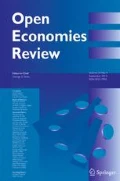Abstract
The current mainstream approach to monetary policy is based on the New Keynesian model and is expressed in terms of a short-term nominal interest, such as the federal funds rate in the United States. It ignores the role of leverage and also downplays the role of money in basic monetary theory and monetary policy analysis. But as the federal funds rate has reached the zero lower bound and the Federal Reserve is in a liquidity trap, the issue is whether there is a useful role of leverage and monetary aggregates in monetary policy and business cycle analysis. We address these issues and argue that there is a need for financial stability policies to manage the leverage cycle and reduce the procyclicality of the financial system. We also argue that in the aftermath of the global financial crisis and Great Contraction there is a need to get away from the New Keynesian thinking and back toward a quantity theory approach to monetary policy, based on properly measured monetary aggregates, such as the new Center for Financial Stability Divisia monetary aggregates.





























Similar content being viewed by others
References
Adrian T, Shin HS (2010) Liquidity and leverage. J Financ Intermed 19:418–437
Adrian T, Shin HS (2011) Financial intermediaries and monetary economics. In: Friedman BM, Woodford M (eds) Monetary economics, vol 3A. North Holland, Amsterdam, pp 601–650
Adrian T, Shin HS (2012) Procyclical leverage and value-at-risk. Federal Reserve Bank of New York Staff Report 338
Anderson RG, Jones BE (2011) A comprehensive revision of the U.S. monetary services (divisia) indexes for the United States. Federal Reserve Bank of St. Louis Review September/October, pp 325–359
Barnett WA (1978) The user cost of money. Econ Lett 1:145–149
Barnett WA (1980) Economic monetary aggregates: an application of aggregation and index number theory. J Econom 14:11–48
Barnett WA (2012) Getting it wrong: how faulty monetary statistics undermine the fed, the financial system, and the economy. The MIT Press, Cambridge
Barnett WA, Chauvet M (2011) How better monetary statistics could have signaled the financial crisis. J Econom 161:6–23
Barnett WA, Serletis A (2000) The theory of monetary aggregation. Contributions to economic analysis, vol 245. North-Holland, Amsterdam
Barnett WA, Diewert EW, Zellner A (2011) Introduction to ‘measurement with theory’. J Econom 161:1–5
Barnett WA, Fisher D, Serletis A (1992) Consumer theory and the demand for money. J Econ Lit 30:2086–2119
Barnett WA, Liu J, Mattson RS, van den Noort J (2013) The new CFS Divisia monetary aggregates: design, construction, and data Sources. Open Econ Rev (forthcoming)
Belongia MT, Ireland PN (2013) The Barnett critique after three decades: a new Keynesian analysis. J Econom (forthcoming)
Bowman D, Gagnon E, Leahy M (2010) Interest on excess reserves as a monetary policy instrument. Board of Governors of the Federal Reserve System, International Finance Discussion Papers, Number 996
Chrystal KA, MacDonald R (1994) Empirical evidence on the recent behavior and usefulness of simple-sum and weighted measures of the money stock. FRBSL Review 76:73–109
Cúrdia V, Woodford M (2011) The central-bank balance sheet as an intsrument of monetary policy. J Monet Econ 58:54–79
Diewert WE (1976) Exact and superlative index numbers. J Econom 4:115–145
Fostel A, Geanakoplos J (2008) Leverage cycles and the anxious economy. Am Econ Rev 98:1211–1244
Geanakoplos J (2010) The leverage cycle. In: Acemoglu D, Rogoff K, Woodford M (eds) NBER macreoconomics annual. University of Chicago Press, Chicago, pp 1–65
Geanakoplos J (2012) Leverage and bubbles: the need to manage the leverage cycle. In: Evanoff DD, Kaufman GG, Malliaris AG (eds) New perspectives on asset price bubbles: theory, evidence, and policy. Oxford University Press, Oxford, pp 387–404
Hamilton JD, Wu JC (2012) The effectiveness of alternative monetary policy tools in a zero lower bound environment. J. Money, Credit Bank 44:3–46
Istiak K, Serletis A (2012) Leverage and the macroeconomy. University of Calgary, Mimeo
Keister T, Martin A, McAndrews J (2008) Divorcing money from monetary molicy. FRBNY Econ Pol Rev 41–56
Kilian L, Vigfusson RJ (2011) Are the responses of the U.S. economy asymmetric in energy price increases and decreases? Q Econom 2:419–453
King RG, Plosser CI, Stock JH, Watson MW (1991) Stochastic trends and economic fluctuations. Am Econ Rev 81:819–840
McCallum BT, Nelson E (1999) An optimizing IS-LM specification for monetary policy and business cycle analysis. J Money, Credit Bank 31:296–316
McCallum BT, Nelson E (2011) Money and inflation: some critical issues. In: Friedman BM, Woodford M (eds) Handbook of monetary economics, vol. 3A. Elsevier, Amsterdam, pp 97–153
Prescott EC (1986) Theory ahead of business cycle measurement. Q Rev - Fed Reserve Bank of Minneapolis Fall 9–22
Serletis A, Gogas P (2012) Divisia monetary aggregates for monetary policy and business cycle analysis. University of Calgary, Mimeo
Serletis A, Rahman S (2009) The output effects of money growth uncertainty: evidence from a multivariate GARCH-in-Mean VAR. Open Econ Rev 20:607–630
Serletis A, Rahman S (2013) The case for divisia money targeting. Macroecon Dyn (forthcoming)
Serletis A, Shahmoradi A (2006) Velocity and the variability of money growth: evidence from a VARMA, GARCH-M model. Macroecon Dyn 10:652–666
Taylor JB (1993) Discretion versus policy rules in practice. Carnegie-Rochester Conf. Ser. Public Policy 39:195–214
Whitesell W (2006) Interest rate corridors and reserves. J Monet Econ 53:1177–1195
Woodford M (2003) Interest and prices: foundations of a theory of monetary policy. Princeton University Press, Princeton
Author information
Authors and Affiliations
Corresponding author
Additional information
This paper was presented at the 16th International Conference on Macroeconomic Analysis and International Finance held on May 24–26, 2012 in the University Campus, Rethymno, Greece.
Rights and permissions
About this article
Cite this article
Serletis, A., Istiak, K. & Gogas, P. Interest Rates, Leverage, and Money. Open Econ Rev 24, 51–78 (2013). https://doi.org/10.1007/s11079-012-9253-5
Published:
Issue Date:
DOI: https://doi.org/10.1007/s11079-012-9253-5




